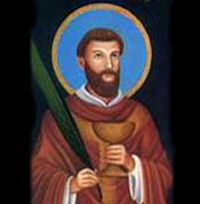Ordinary Time: June 2nd
Friday of the Eighth Week in Ordinary Time; Opt Mem of Sts. Marcellinus and Peter, Martyrs; Ember Friday after Pentecost
Other Commemorations: St. Erasmus, Bishop and Martyr (RM); St. Blandina, Martyr (RM)
Free eBook:
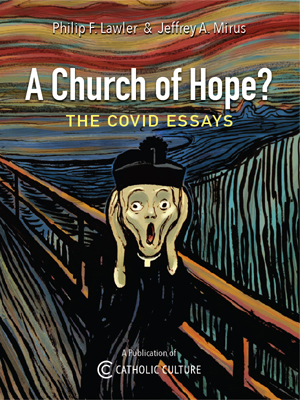
|
| Free eBook: A Church of Hope? |
» Enjoy our Liturgical Seasons series of e-books!
Today is the Optional Memorial of Saints Marcellinus and Peter (d. 304) who were two Roman martyrs who suffered under the Diocletian persecution. The first was an exorcist, the second a priest. Their cultus was so important that after peace was restored to the Church, Constantine built a basilica in their honor. Their names are mentioned in the Canon of the Mass (Eucharistic Prayer I).
The Roman Martyrology commemorates St. Erasmus (d. 303), a bishop in Asia Minor, who was martyred in Campania at about the same time as Marcellinus and Peter. He is one of the Fourteen Holy Helpers.
St. Blandina (d. 177) is also commemorated today. She was a slave in the second century, who had been taken into custody along with her master, also a Christian and died a martyr.
Today is Ember Friday of the Summer or Pentecost Embertide.. The three principle focal points for these Summer Ember Days are: 1) to ask God to bless especially the wheat harvest, 2) to thank God for the season of summer, and 3) to ask for special graces for those being ordained as priests during this season.
The traditional liturgy presents two themes with corresponding moods that to us seem quite conflicting, viz., Ember week penance and Pentecost joy. Assuredly the mentality of the early Church different vastly from ours. While Christians of an earlier age had a most vivid realization of redemption, we have attached greater importance to consciousness of sin. This attitude is the result of the modern humanistic approach to piety. It would benefit us greatly to promote the spirit of the ancient Church, a spirit that exults and rejoices over our liberation from sin and evil. As a model we could take the paralytic in Gospel of the today's traditional liturgy: "He went away to his house, glorifying God."
Ember Friday's Mass liturgy is always somewhat penitential in character. In spirit we are present in the Church of the Twelve Apostles, a church that the ancients associated with penance. Penance, too, is prominent in the Gospel story. For we will resemble the man with palsy if we regret the "sins, offense, and negligences" that we feel victim to during the past quarter year in spite of the innumerable graces and gifts received from God. And Christian confidence will prompt us to imitate the stretcher bearers who did the unusual to reach Jesus. Now, in the Mass, we receive absolution from the Lord Himself, "Your sins are forgiven."
See Summer or Pentecost Ember Days and Contemporary Observation of Ember Days for more information.
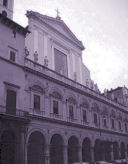
Ember Friday after Pentecost
Station with Santi Dodici Apostoli (the Twelve Holy Apostles, also Santi Apostoli):
Today's station is at the minor basilica of the Twelve Apostles. We are resting upon the Blessed Apostles, the twelve pillars of the Church of God. May we never depart from them. The holy apostles with whom we celebrate this day are indeed our "teachers of justice." If we adhere to them, if we absorb their purity and charity, the dew of the Holy Ghost will descend upon us, as it did in the beginning.
Traditionally, this is the place where the Romans choose their candidates for priesthood (Rite of Election). It was erected by Julius I (337-352) over the barracks of ancient Rome's firemen and entrusted since 1463 to the Conventual Franciscans. Originally dedicated to the Apostles St. James and St. Philip, it was rededicated to all the Apostles in the 16th century.
For more on Santi Dodici Apostoli, see:
For further information on the Station Churches, see The Stational Church.
St. Marcellinus and St. Peter
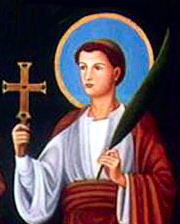 Peter, an exorcist, was cast into prison at Rome, under the emperor Diocletian, by the judge Serenus, for confessing the Christian faith. He there set free Paulina, the daughter of Artemius, the keeper of the prison, from an evil spirit which tormented her. Upon this, Artemius and his wife and all their house, with their neighbors who had run together to see the strange thing, were converted to Jesus Christ. Peter therefore brought them to Marcellinus the priest, who baptized them all. When Serenus heard of it, he called Peter and Marcellinus before him, and sharply rebuked them, adding to his bitter words threats and terrors, unless they would deny Christ. Marcellinus answered him with Christian boldness, whereupon he caused him to be buffeted, separated him from Peter, and shut him up naked, in a prison strewn with broken glass, without either food or light. Peter also he confined. But when both of them were found to increase in faith and courage in their bonds, they were beheaded, unshaken in their testimony, and confessing Jesus Christ gloriously by their blood.
Peter, an exorcist, was cast into prison at Rome, under the emperor Diocletian, by the judge Serenus, for confessing the Christian faith. He there set free Paulina, the daughter of Artemius, the keeper of the prison, from an evil spirit which tormented her. Upon this, Artemius and his wife and all their house, with their neighbors who had run together to see the strange thing, were converted to Jesus Christ. Peter therefore brought them to Marcellinus the priest, who baptized them all. When Serenus heard of it, he called Peter and Marcellinus before him, and sharply rebuked them, adding to his bitter words threats and terrors, unless they would deny Christ. Marcellinus answered him with Christian boldness, whereupon he caused him to be buffeted, separated him from Peter, and shut him up naked, in a prison strewn with broken glass, without either food or light. Peter also he confined. But when both of them were found to increase in faith and courage in their bonds, they were beheaded, unshaken in their testimony, and confessing Jesus Christ gloriously by their blood.
—Excerpted from The Liturgical Year, Abbot Gueranger O.S.B.
Highlights and Things to Do:
- St. Marcellinus and Peter are included in the Roman Martyrology, originally a written catalogue of those saints who shed their blood for Christ during the early centuries of pagan persecution. Local churches celebrated each martyr's "birthday" into heaven, assigning the day of their final victory over the world as their feastday in the liturgical calendar. When she triumphantly arose from the catacombs, the Church gradually introduced other great saints, who were not slain for their faith, into the Martyrology as she combined the recorded Acta of both east and west. An official book of the Roman liturgy, its pages contain the names of thousands of our most valiant Catholic heroes and heroines along with a very brief biographical sketch commemorating either their martyrdom or their most enduring accomplishments.
- Read more about Saints Marcellinus and Peter:
- See Christian Iconography for images of Sts. Marcellinus and Peter.
- Find out more about the relics of St. Marcellinus and Peter.
St. Erasmus
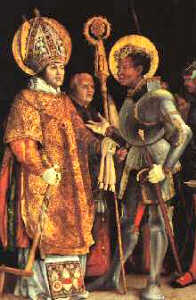 In Campania the bishop Erasmus was, under the empire of Diocletian and Maximian, beaten with clubs and whips loaded with lead, and afterwards plunged into resin, sulphur, melted lead, boiling pitch, wax, and oil. From all this he came forth whole and sound: which wonder converted many to believe in Christ. He was remanded to prison, and bound in iron fetters. But from these he was wondrously delivered by an angel. At last, being taken to Formi, Maximian caused him to be subjected to divers torments, being clad in a coat of red-hot brass, but the power of God made him more than a conqueror in all these things also. Afterwards, having converted many to the faith and confirmed them therein, he obtained the palm of a glorious martyrdom.
In Campania the bishop Erasmus was, under the empire of Diocletian and Maximian, beaten with clubs and whips loaded with lead, and afterwards plunged into resin, sulphur, melted lead, boiling pitch, wax, and oil. From all this he came forth whole and sound: which wonder converted many to believe in Christ. He was remanded to prison, and bound in iron fetters. But from these he was wondrously delivered by an angel. At last, being taken to Formi, Maximian caused him to be subjected to divers torments, being clad in a coat of red-hot brass, but the power of God made him more than a conqueror in all these things also. Afterwards, having converted many to the faith and confirmed them therein, he obtained the palm of a glorious martyrdom.
—Excerpted from The Liturgical Year, Abbot Gueranger O.S.B.
He is invoked for intestinal diseases, for his legend asserts that he was tortured by winding his entrails round a windlass. He is also called St. Elmo, and the static electricity on boats, Saint Elmo's Fire, is named after him. He is one of the Fourteen Holy Helpers.
Patronage: Abdominal pains; ammunition workers; appendicitis; birth pains; boatmen; childbirth; childhood intestinal disease; colic; danger at sea; explosives workers; intestinal disorders; mariners; navigators; ordinance workers; sailors; sea sickness; stomach diseases; storms; watermen; women in labor.
Symbols and Representation: Windlass or capstan wound with his intestines; ship; ravens bringing him bread; cauldron of molten lead; red-hot armour; three-pronged hook; cauldron of boiling pitch or resin.
Highlights and Things to Do:
- Read more about St. Erasmus:
St. Blandina
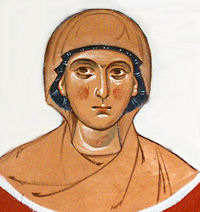 St. Blandina lived as a slave at Lyons, Gaul, in the 2nd century after Christ. She was one of the illustrious company of those martyred under the emperor Marcus Aurelius. She was apprehended together with her master, who was also a Christian. She endured every torment imaginable, to the extent that the tormentors confessed that they could not think of anything else to do to her. And to every question put to her, she gave the same answer: "I am a Christian, and we commit no wrong." Brought to the arena for fresh torments, Blandina was bound to a stake and wild beasts were released upon her but refused to harm her. She witnessed the podvigs (struggles) of all her fellows, and was the last to suffer martyrdom, by being placed on a red hot grate, enclosed in a net, and thrown before a wild steer, who tossed her into the air with his horns. In this manner the great martyr of Christ received her crown.
St. Blandina lived as a slave at Lyons, Gaul, in the 2nd century after Christ. She was one of the illustrious company of those martyred under the emperor Marcus Aurelius. She was apprehended together with her master, who was also a Christian. She endured every torment imaginable, to the extent that the tormentors confessed that they could not think of anything else to do to her. And to every question put to her, she gave the same answer: "I am a Christian, and we commit no wrong." Brought to the arena for fresh torments, Blandina was bound to a stake and wild beasts were released upon her but refused to harm her. She witnessed the podvigs (struggles) of all her fellows, and was the last to suffer martyrdom, by being placed on a red hot grate, enclosed in a net, and thrown before a wild steer, who tossed her into the air with his horns. In this manner the great martyr of Christ received her crown.
Patronage: falsely accused people; girls; Lyon, France; torture victims
Symbols and Representation: bull; depicted tied to a pillar with a lion and bear near her
Highlights and Things to Do:
- There are many accounts of the martyrdom of St. Blandina. Here are several sources:
- Read more about St. Blandina:




